HLT54115 Diploma of Nursing: APH102 Assessment 1 - Patient Analysis
VerifiedAdded on 2023/01/10
|12
|4340
|56
Homework Assignment
AI Summary
This assignment is a response template for Assessment 1 in the HLT54115 Diploma of Nursing, focusing on assessing physical health status. The assessment involves a case study of a 53-year-old male patient, George McFarlane, who presents with elevated blood glucose levels, along with a medical history of type 2 diabetes, osteoarthritis, and smoking. The assignment requires completion of an admission form, analysis of vital signs (blood pressure, temperature, pulse, respirations, and oxygen saturation), and interpretation of urinalysis results. Students are asked to identify abnormal findings, potential contributing factors to the patient's health issues, and the roles of healthcare professionals. Furthermore, the assignment explores the scope of practice of an Enrolled Nurse (EN) in comparison to a Registered Nurse (RN), including responsibilities and reporting procedures. The student provides an admission plan based on the case study and answers questions relating to the patient's health conditions and their related body systems.
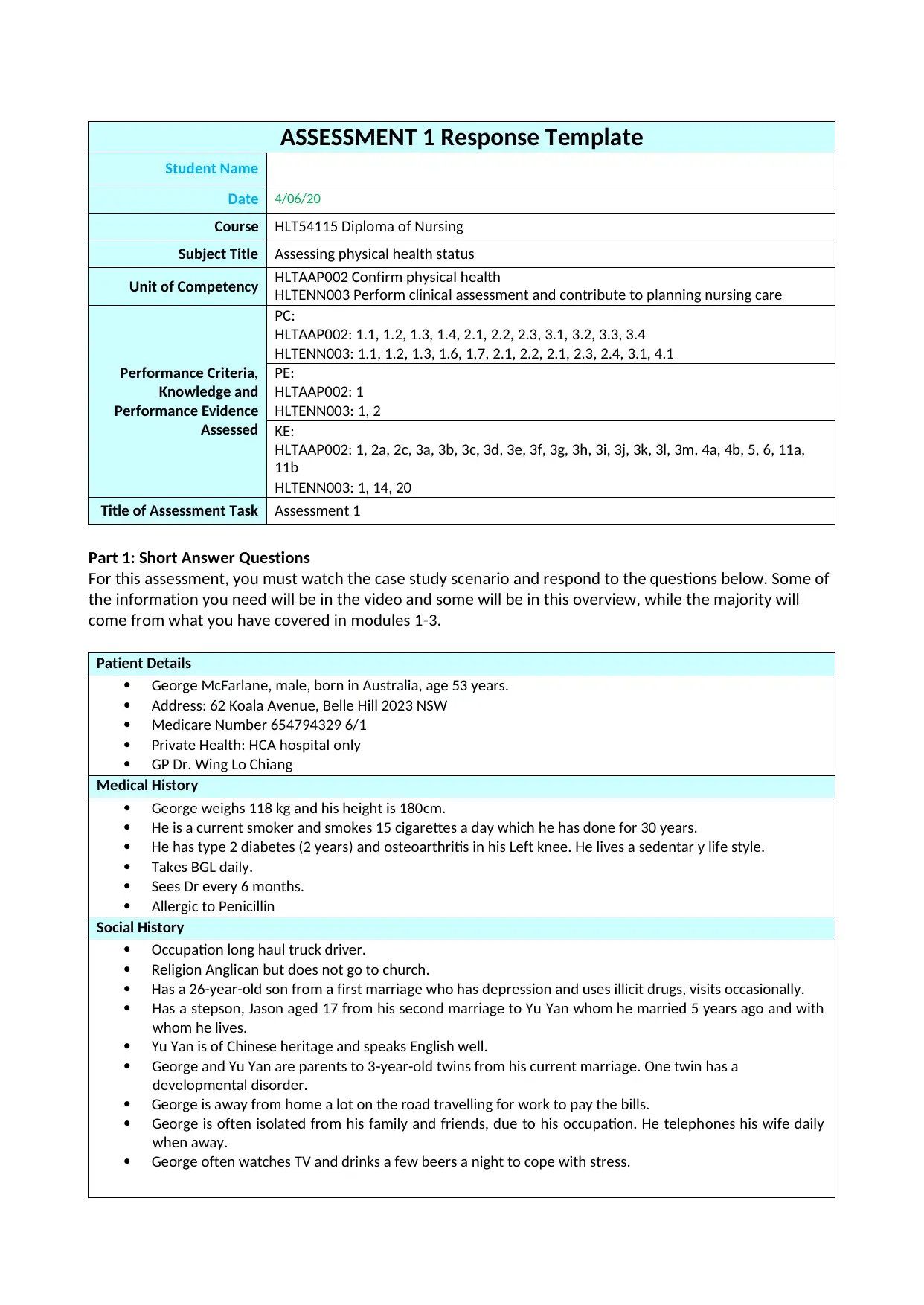
ASSESSMENT 1 Response Template
Student Name
Date 4/06/20
Course HLT54115 Diploma of Nursing
Subject Title Assessing physical health status
Unit of Competency HLTAAP002 Confirm physical health
HLTENN003 Perform clinical assessment and contribute to planning nursing care
Performance Criteria,
Knowledge and
Performance Evidence
Assessed
PC:
HLTAAP002: 1.1, 1.2, 1.3, 1.4, 2.1, 2.2, 2.3, 3.1, 3.2, 3.3, 3.4
HLTENN003: 1.1, 1.2, 1.3, 1.6, 1,7, 2.1, 2.2, 2.1, 2.3, 2.4, 3.1, 4.1
PE:
HLTAAP002: 1
HLTENN003: 1, 2
KE:
HLTAAP002: 1, 2a, 2c, 3a, 3b, 3c, 3d, 3e, 3f, 3g, 3h, 3i, 3j, 3k, 3l, 3m, 4a, 4b, 5, 6, 11a,
11b
HLTENN003: 1, 14, 20
Title of Assessment Task Assessment 1
Part 1: Short Answer Questions
For this assessment, you must watch the case study scenario and respond to the questions below. Some of
the information you need will be in the video and some will be in this overview, while the majority will
come from what you have covered in modules 1-3.
Patient Details
George McFarlane, male, born in Australia, age 53 years.
Address: 62 Koala Avenue, Belle Hill 2023 NSW
Medicare Number 654794329 6/1
Private Health: HCA hospital only
GP Dr. Wing Lo Chiang
Medical History
George weighs 118 kg and his height is 180cm.
He is a current smoker and smokes 15 cigarettes a day which he has done for 30 years.
He has type 2 diabetes (2 years) and osteoarthritis in his Left knee. He lives a sedentar y life style.
Takes BGL daily.
Sees Dr every 6 months.
Allergic to Penicillin
Social History
Occupation long haul truck driver.
Religion Anglican but does not go to church.
Has a 26-year-old son from a first marriage who has depression and uses illicit drugs, visits occasionally.
Has a stepson, Jason aged 17 from his second marriage to Yu Yan whom he married 5 years ago and with
whom he lives.
Yu Yan is of Chinese heritage and speaks English well.
George and Yu Yan are parents to 3-year-old twins from his current marriage. One twin has a
developmental disorder.
George is away from home a lot on the road travelling for work to pay the bills.
George is often isolated from his family and friends, due to his occupation. He telephones his wife daily
when away.
George often watches TV and drinks a few beers a night to cope with stress.
Student Name
Date 4/06/20
Course HLT54115 Diploma of Nursing
Subject Title Assessing physical health status
Unit of Competency HLTAAP002 Confirm physical health
HLTENN003 Perform clinical assessment and contribute to planning nursing care
Performance Criteria,
Knowledge and
Performance Evidence
Assessed
PC:
HLTAAP002: 1.1, 1.2, 1.3, 1.4, 2.1, 2.2, 2.3, 3.1, 3.2, 3.3, 3.4
HLTENN003: 1.1, 1.2, 1.3, 1.6, 1,7, 2.1, 2.2, 2.1, 2.3, 2.4, 3.1, 4.1
PE:
HLTAAP002: 1
HLTENN003: 1, 2
KE:
HLTAAP002: 1, 2a, 2c, 3a, 3b, 3c, 3d, 3e, 3f, 3g, 3h, 3i, 3j, 3k, 3l, 3m, 4a, 4b, 5, 6, 11a,
11b
HLTENN003: 1, 14, 20
Title of Assessment Task Assessment 1
Part 1: Short Answer Questions
For this assessment, you must watch the case study scenario and respond to the questions below. Some of
the information you need will be in the video and some will be in this overview, while the majority will
come from what you have covered in modules 1-3.
Patient Details
George McFarlane, male, born in Australia, age 53 years.
Address: 62 Koala Avenue, Belle Hill 2023 NSW
Medicare Number 654794329 6/1
Private Health: HCA hospital only
GP Dr. Wing Lo Chiang
Medical History
George weighs 118 kg and his height is 180cm.
He is a current smoker and smokes 15 cigarettes a day which he has done for 30 years.
He has type 2 diabetes (2 years) and osteoarthritis in his Left knee. He lives a sedentar y life style.
Takes BGL daily.
Sees Dr every 6 months.
Allergic to Penicillin
Social History
Occupation long haul truck driver.
Religion Anglican but does not go to church.
Has a 26-year-old son from a first marriage who has depression and uses illicit drugs, visits occasionally.
Has a stepson, Jason aged 17 from his second marriage to Yu Yan whom he married 5 years ago and with
whom he lives.
Yu Yan is of Chinese heritage and speaks English well.
George and Yu Yan are parents to 3-year-old twins from his current marriage. One twin has a
developmental disorder.
George is away from home a lot on the road travelling for work to pay the bills.
George is often isolated from his family and friends, due to his occupation. He telephones his wife daily
when away.
George often watches TV and drinks a few beers a night to cope with stress.
Paraphrase This Document
Need a fresh take? Get an instant paraphrase of this document with our AI Paraphraser
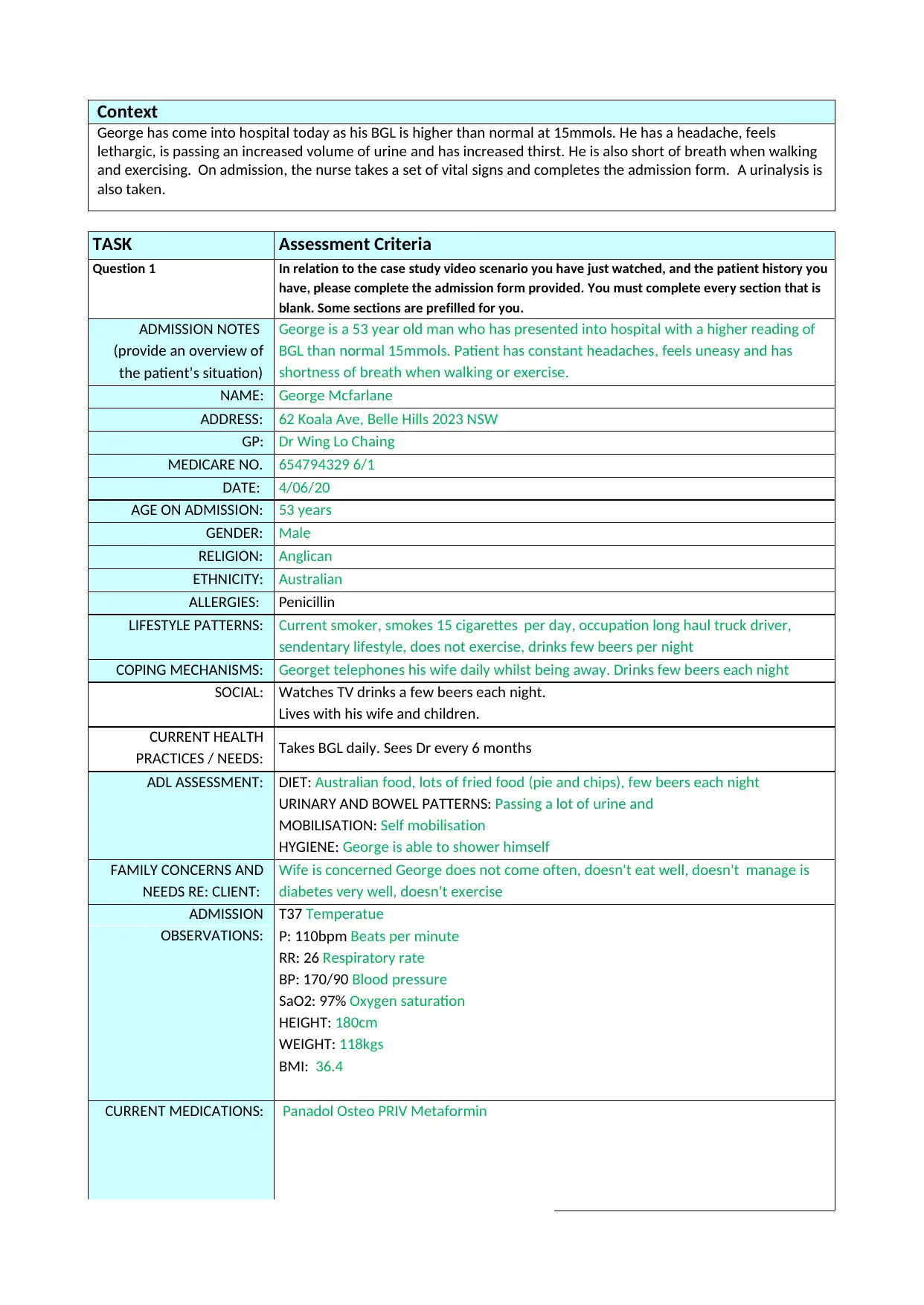
Context
George has come into hospital today as his BGL is higher than normal at 15mmols. He has a headache, feels
lethargic, is passing an increased volume of urine and has increased thirst. He is also short of breath when walking
and exercising. On admission, the nurse takes a set of vital signs and completes the admission form. A urinalysis is
also taken.
TASK Assessment Criteria
Question 1 In relation to the case study video scenario you have just watched, and the patient history you
have, please complete the admission form provided. You must complete every section that is
blank. Some sections are prefilled for you.
ADMISSION NOTES George is a 53 year old man who has presented into hospital with a higher reading of
BGL than normal 15mmols. Patient has constant headaches, feels uneasy and has
shortness of breath when walking or exercise.
(provide an overview of
the patient’s situation)
NAME: George Mcfarlane
ADDRESS: 62 Koala Ave, Belle Hills 2023 NSW
GP: Dr Wing Lo Chaing
MEDICARE NO. 654794329 6/1
DATE: 4/06/20
AGE ON ADMISSION: 53 years
GENDER: Male
RELIGION: Anglican
ETHNICITY: Australian
ALLERGIES: Penicillin
LIFESTYLE PATTERNS: Current smoker, smokes 15 cigarettes per day, occupation long haul truck driver,
sendentary lifestyle, does not exercise, drinks few beers per night
COPING MECHANISMS: Georget telephones his wife daily whilst being away. Drinks few beers each night
SOCIAL: Watches TV drinks a few beers each night.
Lives with his wife and children.
CURRENT HEALTH
PRACTICES / NEEDS: Takes BGL daily. Sees Dr every 6 months
ADL ASSESSMENT: DIET: Australian food, lots of fried food (pie and chips), few beers each night
URINARY AND BOWEL PATTERNS: Passing a lot of urine and
MOBILISATION: Self mobilisation
HYGIENE: George is able to shower himself
FAMILY CONCERNS AND
NEEDS RE: CLIENT:
Wife is concerned George does not come often, doesn't eat well, doesn't manage is
diabetes very well, doesn't exercise
ADMISSION T37 Temperatue
P: 110bpm Beats per minute
RR: 26 Respiratory rate
BP: 170/90 Blood pressure
SaO2: 97% Oxygen saturation
HEIGHT: 180cm
WEIGHT: 118kgs
BMI: 36.4
OBSERVATIONS:
CURRENT MEDICATIONS: Panadol Osteo PRIV Metaformin
George has come into hospital today as his BGL is higher than normal at 15mmols. He has a headache, feels
lethargic, is passing an increased volume of urine and has increased thirst. He is also short of breath when walking
and exercising. On admission, the nurse takes a set of vital signs and completes the admission form. A urinalysis is
also taken.
TASK Assessment Criteria
Question 1 In relation to the case study video scenario you have just watched, and the patient history you
have, please complete the admission form provided. You must complete every section that is
blank. Some sections are prefilled for you.
ADMISSION NOTES George is a 53 year old man who has presented into hospital with a higher reading of
BGL than normal 15mmols. Patient has constant headaches, feels uneasy and has
shortness of breath when walking or exercise.
(provide an overview of
the patient’s situation)
NAME: George Mcfarlane
ADDRESS: 62 Koala Ave, Belle Hills 2023 NSW
GP: Dr Wing Lo Chaing
MEDICARE NO. 654794329 6/1
DATE: 4/06/20
AGE ON ADMISSION: 53 years
GENDER: Male
RELIGION: Anglican
ETHNICITY: Australian
ALLERGIES: Penicillin
LIFESTYLE PATTERNS: Current smoker, smokes 15 cigarettes per day, occupation long haul truck driver,
sendentary lifestyle, does not exercise, drinks few beers per night
COPING MECHANISMS: Georget telephones his wife daily whilst being away. Drinks few beers each night
SOCIAL: Watches TV drinks a few beers each night.
Lives with his wife and children.
CURRENT HEALTH
PRACTICES / NEEDS: Takes BGL daily. Sees Dr every 6 months
ADL ASSESSMENT: DIET: Australian food, lots of fried food (pie and chips), few beers each night
URINARY AND BOWEL PATTERNS: Passing a lot of urine and
MOBILISATION: Self mobilisation
HYGIENE: George is able to shower himself
FAMILY CONCERNS AND
NEEDS RE: CLIENT:
Wife is concerned George does not come often, doesn't eat well, doesn't manage is
diabetes very well, doesn't exercise
ADMISSION T37 Temperatue
P: 110bpm Beats per minute
RR: 26 Respiratory rate
BP: 170/90 Blood pressure
SaO2: 97% Oxygen saturation
HEIGHT: 180cm
WEIGHT: 118kgs
BMI: 36.4
OBSERVATIONS:
CURRENT MEDICATIONS: Panadol Osteo PRIV Metaformin
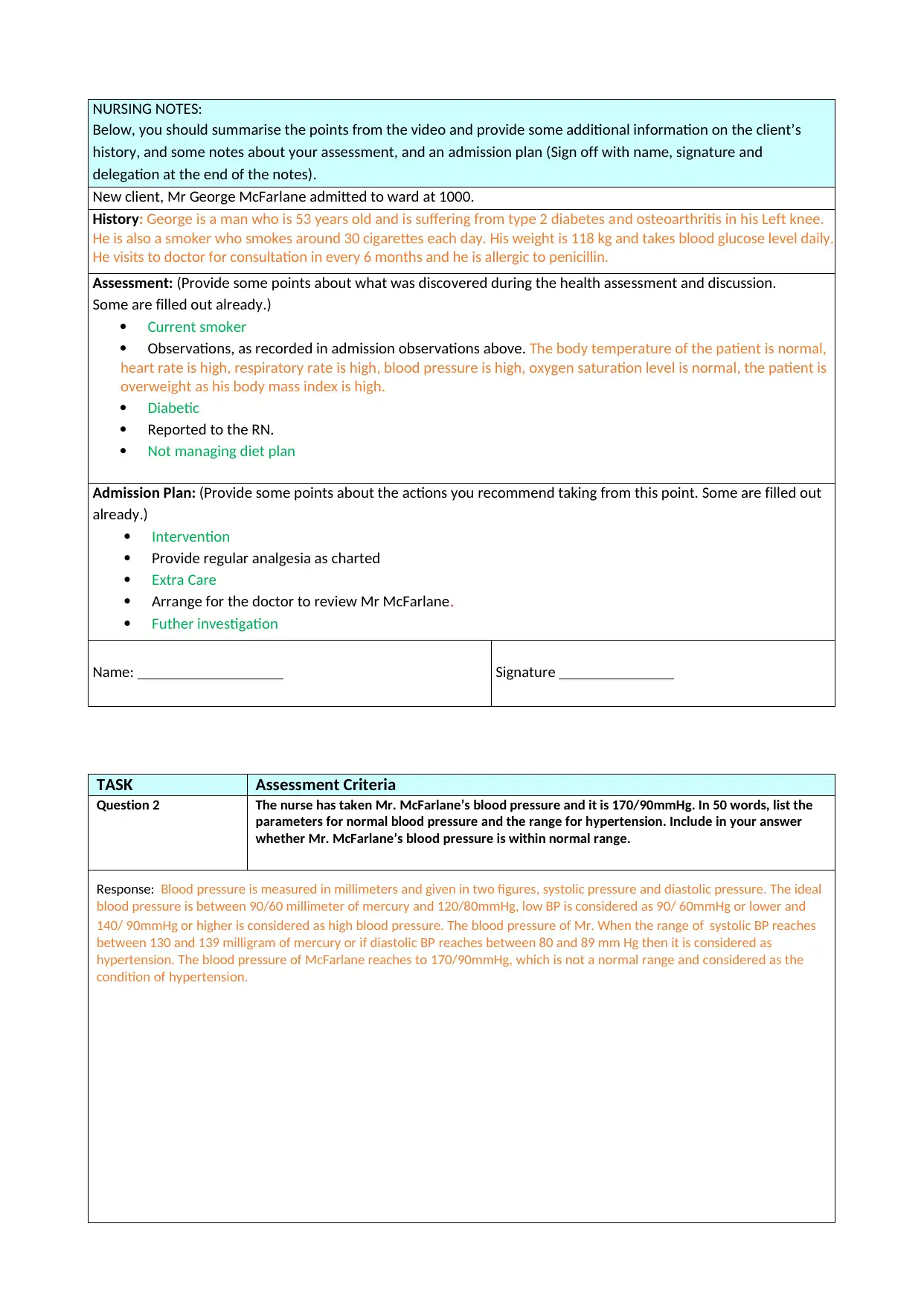
NURSING NOTES:
Below, you should summarise the points from the video and provide some additional information on the client’s
history, and some notes about your assessment, and an admission plan (Sign off with name, signature and
delegation at the end of the notes).
New client, Mr George McFarlane admitted to ward at 1000.
History: George is a man who is 53 years old and is suffering from type 2 diabetes and osteoarthritis in his Left knee.
He is also a smoker who smokes around 30 cigarettes each day. His weight is 118 kg and takes blood glucose level daily.
He visits to doctor for consultation in every 6 months and he is allergic to penicillin.
Assessment: (Provide some points about what was discovered during the health assessment and discussion.
Some are filled out already.)
Current smoker
Observations, as recorded in admission observations above. The body temperature of the patient is normal,
heart rate is high, respiratory rate is high, blood pressure is high, oxygen saturation level is normal, the patient is
overweight as his body mass index is high.
Diabetic
Reported to the RN.
Not managing diet plan
Admission Plan: (Provide some points about the actions you recommend taking from this point. Some are filled out
already.)
Intervention
Provide regular analgesia as charted
Extra Care
Arrange for the doctor to review Mr McFarlane.
Futher investigation
Name: Signature
TASK Assessment Criteria
Question 2 The nurse has taken Mr. McFarlane’s blood pressure and it is 170/90mmHg. In 50 words, list the
parameters for normal blood pressure and the range for hypertension. Include in your answer
whether Mr. McFarlane’s blood pressure is within normal range.
Response: Blood pressure is measured in millimeters and given in two figures, systolic pressure and diastolic pressure. The ideal
blood pressure is between 90/60 millimeter of mercury and 120/80mmHg, low BP is considered as 90/ 60mmHg or lower and
140/ 90mmHg or higher is considered as high blood pressure. The blood pressure of Mr. When the range of systolic BP reaches
between 130 and 139 milligram of mercury or if diastolic BP reaches between 80 and 89 mm Hg then it is considered as
hypertension. The blood pressure of McFarlane reaches to 170/90mmHg, which is not a normal range and considered as the
condition of hypertension.
Below, you should summarise the points from the video and provide some additional information on the client’s
history, and some notes about your assessment, and an admission plan (Sign off with name, signature and
delegation at the end of the notes).
New client, Mr George McFarlane admitted to ward at 1000.
History: George is a man who is 53 years old and is suffering from type 2 diabetes and osteoarthritis in his Left knee.
He is also a smoker who smokes around 30 cigarettes each day. His weight is 118 kg and takes blood glucose level daily.
He visits to doctor for consultation in every 6 months and he is allergic to penicillin.
Assessment: (Provide some points about what was discovered during the health assessment and discussion.
Some are filled out already.)
Current smoker
Observations, as recorded in admission observations above. The body temperature of the patient is normal,
heart rate is high, respiratory rate is high, blood pressure is high, oxygen saturation level is normal, the patient is
overweight as his body mass index is high.
Diabetic
Reported to the RN.
Not managing diet plan
Admission Plan: (Provide some points about the actions you recommend taking from this point. Some are filled out
already.)
Intervention
Provide regular analgesia as charted
Extra Care
Arrange for the doctor to review Mr McFarlane.
Futher investigation
Name: Signature
TASK Assessment Criteria
Question 2 The nurse has taken Mr. McFarlane’s blood pressure and it is 170/90mmHg. In 50 words, list the
parameters for normal blood pressure and the range for hypertension. Include in your answer
whether Mr. McFarlane’s blood pressure is within normal range.
Response: Blood pressure is measured in millimeters and given in two figures, systolic pressure and diastolic pressure. The ideal
blood pressure is between 90/60 millimeter of mercury and 120/80mmHg, low BP is considered as 90/ 60mmHg or lower and
140/ 90mmHg or higher is considered as high blood pressure. The blood pressure of Mr. When the range of systolic BP reaches
between 130 and 139 milligram of mercury or if diastolic BP reaches between 80 and 89 mm Hg then it is considered as
hypertension. The blood pressure of McFarlane reaches to 170/90mmHg, which is not a normal range and considered as the
condition of hypertension.
⊘ This is a preview!⊘
Do you want full access?
Subscribe today to unlock all pages.

Trusted by 1+ million students worldwide
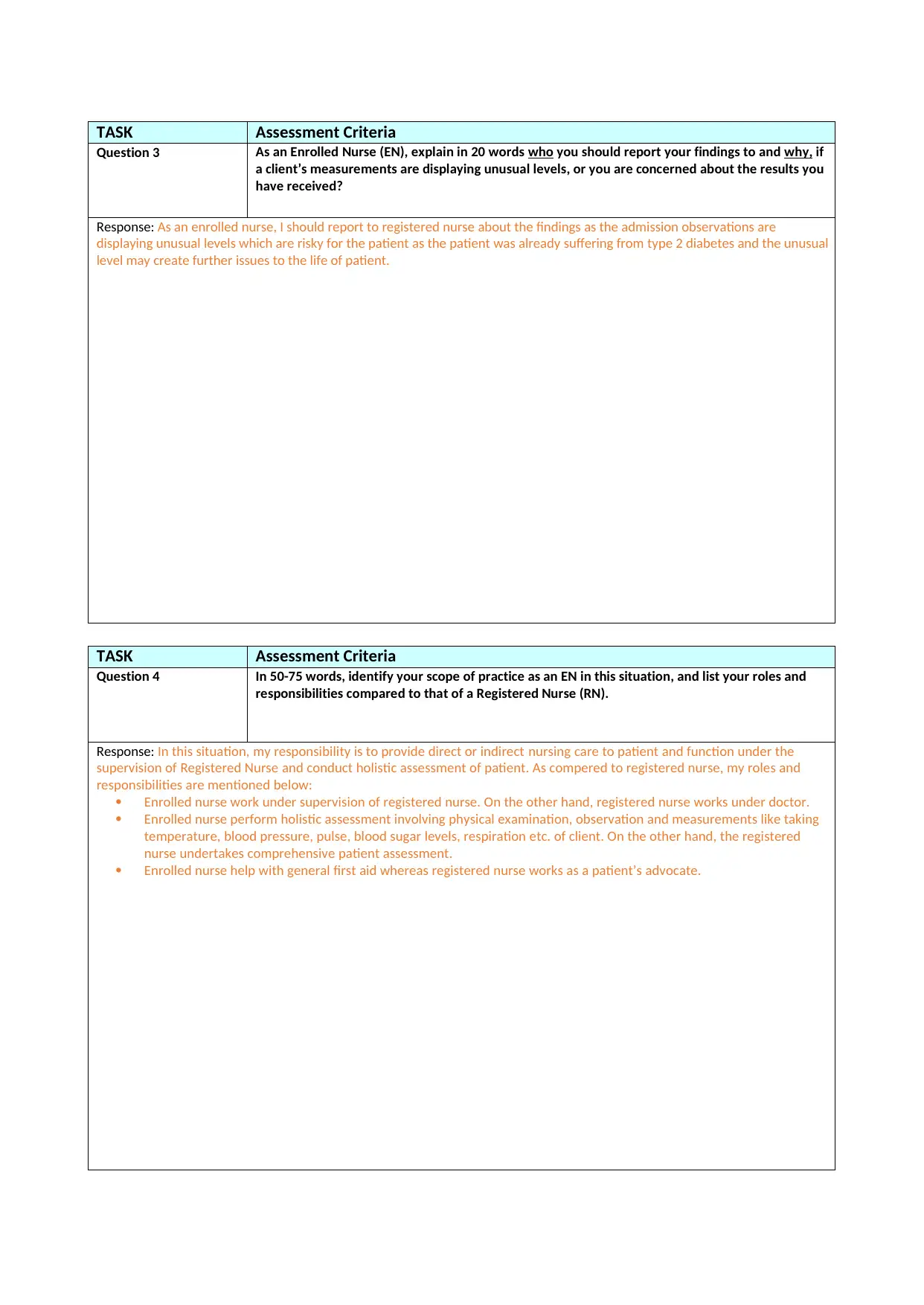
TASK Assessment Criteria
Question 3 As an Enrolled Nurse (EN), explain in 20 words who you should report your findings to and why, if
a client’s measurements are displaying unusual levels, or you are concerned about the results you
have received?
Response: As an enrolled nurse, I should report to registered nurse about the findings as the admission observations are
displaying unusual levels which are risky for the patient as the patient was already suffering from type 2 diabetes and the unusual
level may create further issues to the life of patient.
TASK Assessment Criteria
Question 4 In 50-75 words, identify your scope of practice as an EN in this situation, and list your roles and
responsibilities compared to that of a Registered Nurse (RN).
Response: In this situation, my responsibility is to provide direct or indirect nursing care to patient and function under the
supervision of Registered Nurse and conduct holistic assessment of patient. As compered to registered nurse, my roles and
responsibilities are mentioned below:
Enrolled nurse work under supervision of registered nurse. On the other hand, registered nurse works under doctor.
Enrolled nurse perform holistic assessment involving physical examination, observation and measurements like taking
temperature, blood pressure, pulse, blood sugar levels, respiration etc. of client. On the other hand, the registered
nurse undertakes comprehensive patient assessment.
Enrolled nurse help with general first aid whereas registered nurse works as a patient’s advocate.
Question 3 As an Enrolled Nurse (EN), explain in 20 words who you should report your findings to and why, if
a client’s measurements are displaying unusual levels, or you are concerned about the results you
have received?
Response: As an enrolled nurse, I should report to registered nurse about the findings as the admission observations are
displaying unusual levels which are risky for the patient as the patient was already suffering from type 2 diabetes and the unusual
level may create further issues to the life of patient.
TASK Assessment Criteria
Question 4 In 50-75 words, identify your scope of practice as an EN in this situation, and list your roles and
responsibilities compared to that of a Registered Nurse (RN).
Response: In this situation, my responsibility is to provide direct or indirect nursing care to patient and function under the
supervision of Registered Nurse and conduct holistic assessment of patient. As compered to registered nurse, my roles and
responsibilities are mentioned below:
Enrolled nurse work under supervision of registered nurse. On the other hand, registered nurse works under doctor.
Enrolled nurse perform holistic assessment involving physical examination, observation and measurements like taking
temperature, blood pressure, pulse, blood sugar levels, respiration etc. of client. On the other hand, the registered
nurse undertakes comprehensive patient assessment.
Enrolled nurse help with general first aid whereas registered nurse works as a patient’s advocate.
Paraphrase This Document
Need a fresh take? Get an instant paraphrase of this document with our AI Paraphraser
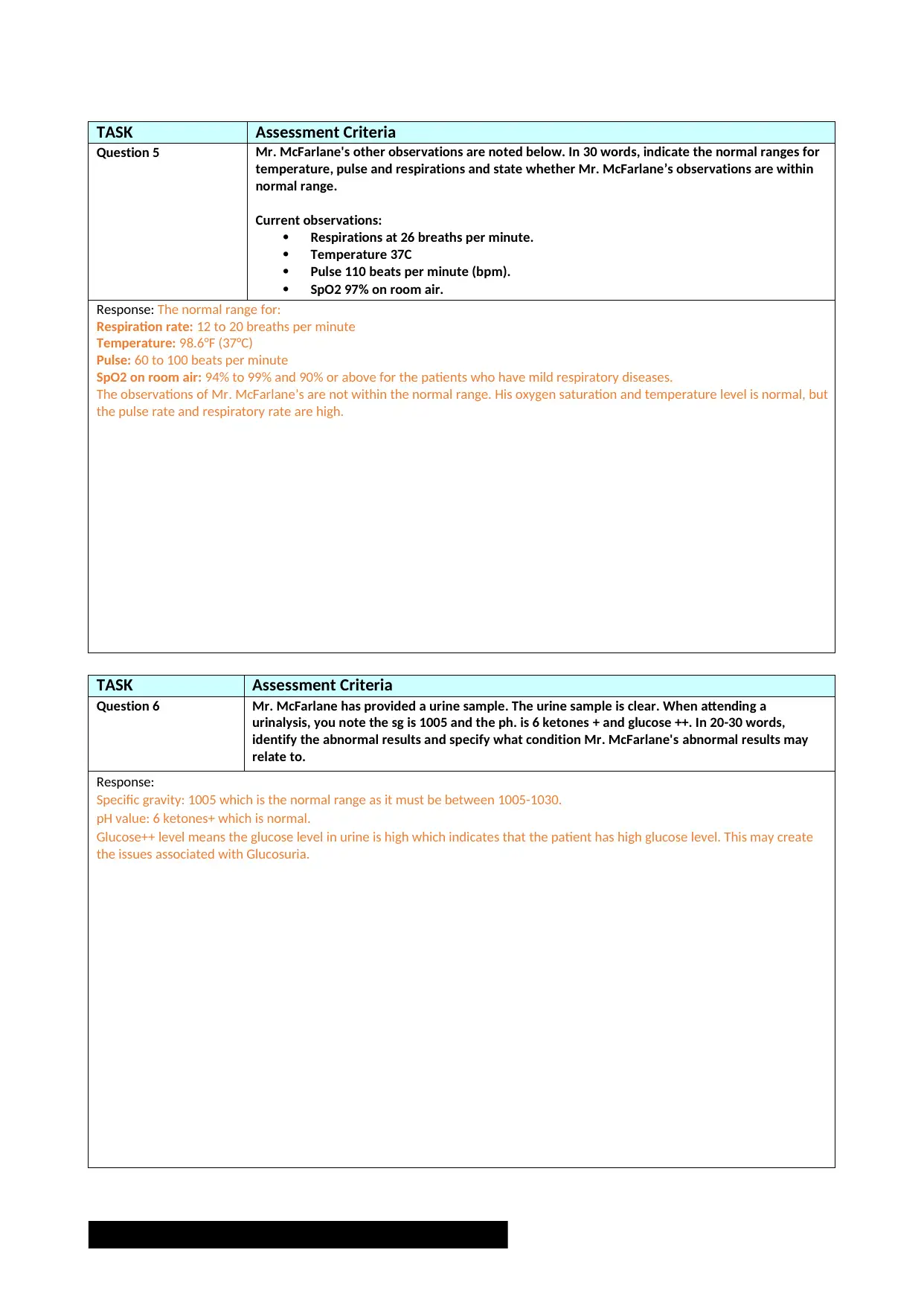
TASK Assessment Criteria
Question 5 Mr. McFarlane's other observations are noted below. In 30 words, indicate the normal ranges for
temperature, pulse and respirations and state whether Mr. McFarlane’s observations are within
normal range.
Current observations:
Respirations at 26 breaths per minute.
Temperature 37C
Pulse 110 beats per minute (bpm).
SpO2 97% on room air.
Response: The normal range for:
Respiration rate: 12 to 20 breaths per minute
Temperature: 98.6°F (37°C)
Pulse: 60 to 100 beats per minute
SpO2 on room air: 94% to 99% and 90% or above for the patients who have mild respiratory diseases.
The observations of Mr. McFarlane’s are not within the normal range. His oxygen saturation and temperature level is normal, but
the pulse rate and respiratory rate are high.
TASK Assessment Criteria
Question 6 Mr. McFarlane has provided a urine sample. The urine sample is clear. When attending a
urinalysis, you note the sg is 1005 and the ph. is 6 ketones + and glucose ++. In 20-30 words,
identify the abnormal results and specify what condition Mr. McFarlane's abnormal results may
relate to.
Response:
Specific gravity: 1005 which is the normal range as it must be between 1005-1030.
pH value: 6 ketones+ which is normal.
Glucose++ level means the glucose level in urine is high which indicates that the patient has high glucose level. This may create
the issues associated with Glucosuria.
Question 5 Mr. McFarlane's other observations are noted below. In 30 words, indicate the normal ranges for
temperature, pulse and respirations and state whether Mr. McFarlane’s observations are within
normal range.
Current observations:
Respirations at 26 breaths per minute.
Temperature 37C
Pulse 110 beats per minute (bpm).
SpO2 97% on room air.
Response: The normal range for:
Respiration rate: 12 to 20 breaths per minute
Temperature: 98.6°F (37°C)
Pulse: 60 to 100 beats per minute
SpO2 on room air: 94% to 99% and 90% or above for the patients who have mild respiratory diseases.
The observations of Mr. McFarlane’s are not within the normal range. His oxygen saturation and temperature level is normal, but
the pulse rate and respiratory rate are high.
TASK Assessment Criteria
Question 6 Mr. McFarlane has provided a urine sample. The urine sample is clear. When attending a
urinalysis, you note the sg is 1005 and the ph. is 6 ketones + and glucose ++. In 20-30 words,
identify the abnormal results and specify what condition Mr. McFarlane's abnormal results may
relate to.
Response:
Specific gravity: 1005 which is the normal range as it must be between 1005-1030.
pH value: 6 ketones+ which is normal.
Glucose++ level means the glucose level in urine is high which indicates that the patient has high glucose level. This may create
the issues associated with Glucosuria.
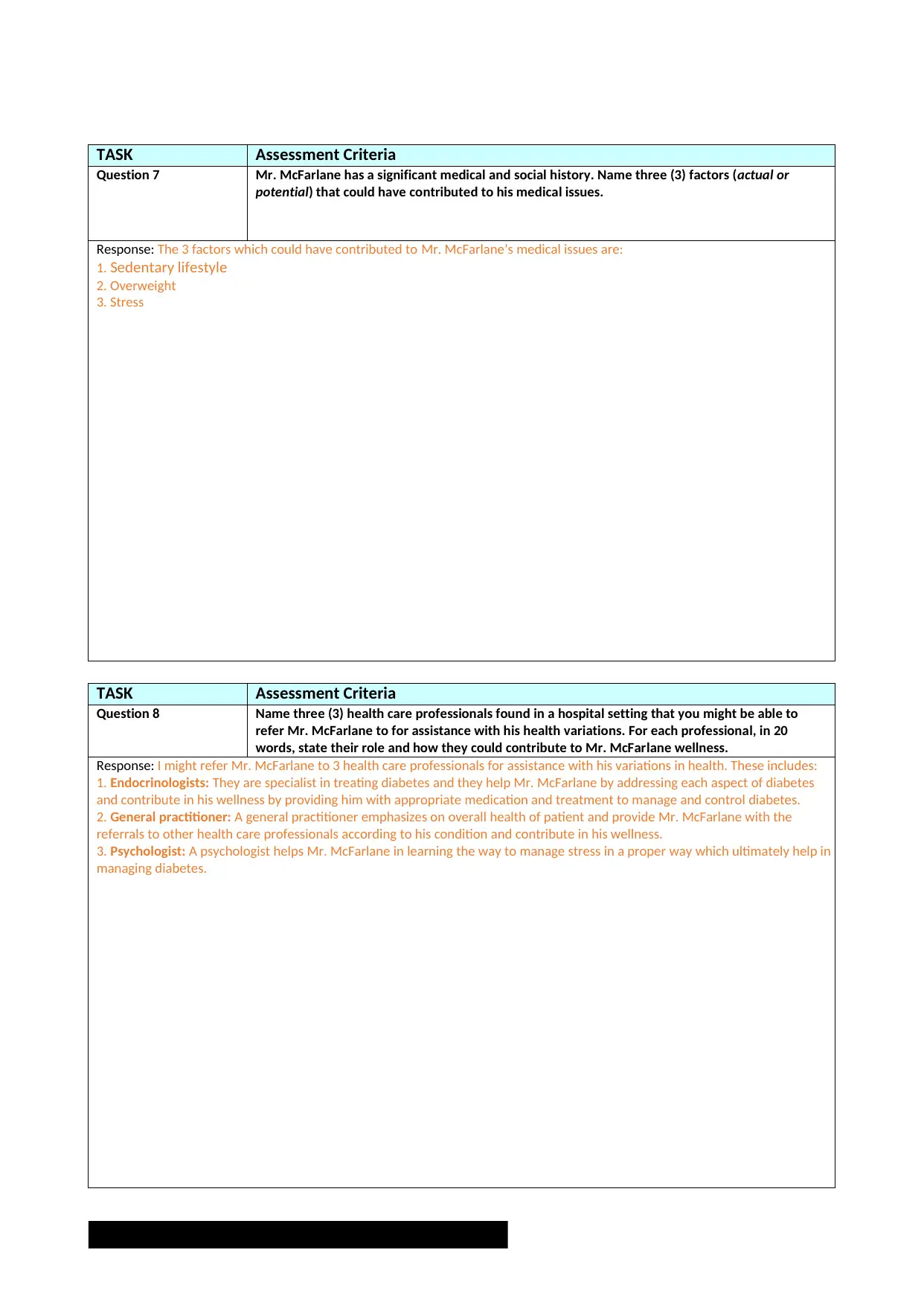
TASK Assessment Criteria
Question 7 Mr. McFarlane has a significant medical and social history. Name three (3) factors (actual or
potential) that could have contributed to his medical issues.
Response: The 3 factors which could have contributed to Mr. McFarlane’s medical issues are:
1. Sedentary lifestyle
2. Overweight
3. Stress
TASK Assessment Criteria
Question 8 Name three (3) health care professionals found in a hospital setting that you might be able to
refer Mr. McFarlane to for assistance with his health variations. For each professional, in 20
words, state their role and how they could contribute to Mr. McFarlane wellness.
Response: I might refer Mr. McFarlane to 3 health care professionals for assistance with his variations in health. These includes:
1. Endocrinologists: They are specialist in treating diabetes and they help Mr. McFarlane by addressing each aspect of diabetes
and contribute in his wellness by providing him with appropriate medication and treatment to manage and control diabetes.
2. General practitioner: A general practitioner emphasizes on overall health of patient and provide Mr. McFarlane with the
referrals to other health care professionals according to his condition and contribute in his wellness.
3. Psychologist: A psychologist helps Mr. McFarlane in learning the way to manage stress in a proper way which ultimately help in
managing diabetes.
Question 7 Mr. McFarlane has a significant medical and social history. Name three (3) factors (actual or
potential) that could have contributed to his medical issues.
Response: The 3 factors which could have contributed to Mr. McFarlane’s medical issues are:
1. Sedentary lifestyle
2. Overweight
3. Stress
TASK Assessment Criteria
Question 8 Name three (3) health care professionals found in a hospital setting that you might be able to
refer Mr. McFarlane to for assistance with his health variations. For each professional, in 20
words, state their role and how they could contribute to Mr. McFarlane wellness.
Response: I might refer Mr. McFarlane to 3 health care professionals for assistance with his variations in health. These includes:
1. Endocrinologists: They are specialist in treating diabetes and they help Mr. McFarlane by addressing each aspect of diabetes
and contribute in his wellness by providing him with appropriate medication and treatment to manage and control diabetes.
2. General practitioner: A general practitioner emphasizes on overall health of patient and provide Mr. McFarlane with the
referrals to other health care professionals according to his condition and contribute in his wellness.
3. Psychologist: A psychologist helps Mr. McFarlane in learning the way to manage stress in a proper way which ultimately help in
managing diabetes.
⊘ This is a preview!⊘
Do you want full access?
Subscribe today to unlock all pages.

Trusted by 1+ million students worldwide
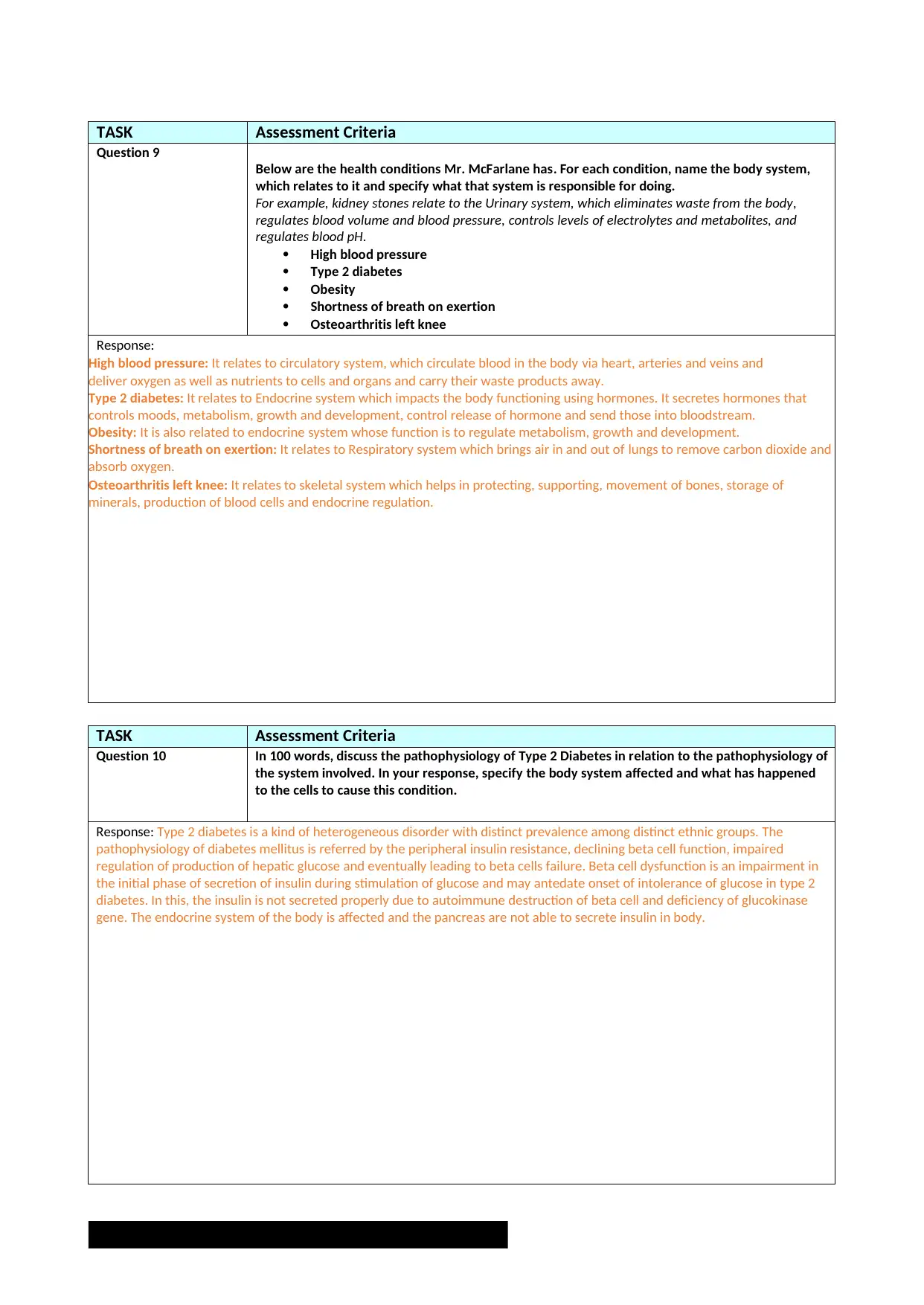
TASK Assessment Criteria
Question 9
Below are the health conditions Mr. McFarlane has. For each condition, name the body system,
which relates to it and specify what that system is responsible for doing.
For example, kidney stones relate to the Urinary system, which eliminates waste from the body,
regulates blood volume and blood pressure, controls levels of electrolytes and metabolites, and
regulates blood pH.
High blood pressure
Type 2 diabetes
Obesity
Shortness of breath on exertion
Osteoarthritis left knee
Response:
High blood pressure: It relates to circulatory system, which circulate blood in the body via heart, arteries and veins and
deliver oxygen as well as nutrients to cells and organs and carry their waste products away.
Type 2 diabetes: It relates to Endocrine system which impacts the body functioning using hormones. It secretes hormones that
controls moods, metabolism, growth and development, control release of hormone and send those into bloodstream.
Obesity: It is also related to endocrine system whose function is to regulate metabolism, growth and development.
Shortness of breath on exertion: It relates to Respiratory system which brings air in and out of lungs to remove carbon dioxide and
absorb oxygen.
Osteoarthritis left knee: It relates to skeletal system which helps in protecting, supporting, movement of bones, storage of
minerals, production of blood cells and endocrine regulation.
TASK Assessment Criteria
Question 10 In 100 words, discuss the pathophysiology of Type 2 Diabetes in relation to the pathophysiology of
the system involved. In your response, specify the body system affected and what has happened
to the cells to cause this condition.
Response: Type 2 diabetes is a kind of heterogeneous disorder with distinct prevalence among distinct ethnic groups. The
pathophysiology of diabetes mellitus is referred by the peripheral insulin resistance, declining beta cell function, impaired
regulation of production of hepatic glucose and eventually leading to beta cells failure. Beta cell dysfunction is an impairment in
the initial phase of secretion of insulin during stimulation of glucose and may antedate onset of intolerance of glucose in type 2
diabetes. In this, the insulin is not secreted properly due to autoimmune destruction of beta cell and deficiency of glucokinase
gene. The endocrine system of the body is affected and the pancreas are not able to secrete insulin in body.
Question 9
Below are the health conditions Mr. McFarlane has. For each condition, name the body system,
which relates to it and specify what that system is responsible for doing.
For example, kidney stones relate to the Urinary system, which eliminates waste from the body,
regulates blood volume and blood pressure, controls levels of electrolytes and metabolites, and
regulates blood pH.
High blood pressure
Type 2 diabetes
Obesity
Shortness of breath on exertion
Osteoarthritis left knee
Response:
High blood pressure: It relates to circulatory system, which circulate blood in the body via heart, arteries and veins and
deliver oxygen as well as nutrients to cells and organs and carry their waste products away.
Type 2 diabetes: It relates to Endocrine system which impacts the body functioning using hormones. It secretes hormones that
controls moods, metabolism, growth and development, control release of hormone and send those into bloodstream.
Obesity: It is also related to endocrine system whose function is to regulate metabolism, growth and development.
Shortness of breath on exertion: It relates to Respiratory system which brings air in and out of lungs to remove carbon dioxide and
absorb oxygen.
Osteoarthritis left knee: It relates to skeletal system which helps in protecting, supporting, movement of bones, storage of
minerals, production of blood cells and endocrine regulation.
TASK Assessment Criteria
Question 10 In 100 words, discuss the pathophysiology of Type 2 Diabetes in relation to the pathophysiology of
the system involved. In your response, specify the body system affected and what has happened
to the cells to cause this condition.
Response: Type 2 diabetes is a kind of heterogeneous disorder with distinct prevalence among distinct ethnic groups. The
pathophysiology of diabetes mellitus is referred by the peripheral insulin resistance, declining beta cell function, impaired
regulation of production of hepatic glucose and eventually leading to beta cells failure. Beta cell dysfunction is an impairment in
the initial phase of secretion of insulin during stimulation of glucose and may antedate onset of intolerance of glucose in type 2
diabetes. In this, the insulin is not secreted properly due to autoimmune destruction of beta cell and deficiency of glucokinase
gene. The endocrine system of the body is affected and the pancreas are not able to secrete insulin in body.
Paraphrase This Document
Need a fresh take? Get an instant paraphrase of this document with our AI Paraphraser
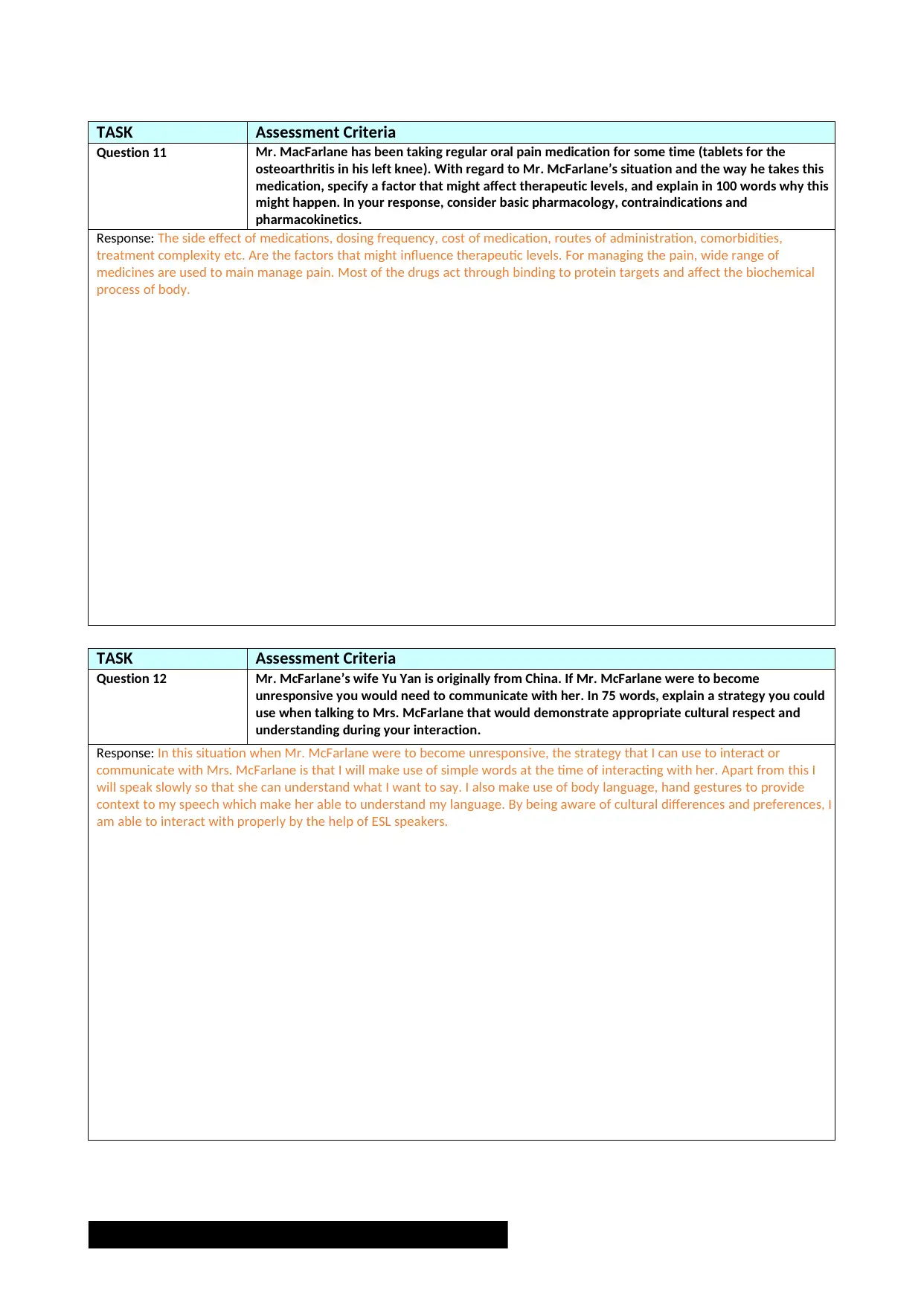
TASK Assessment Criteria
Question 11 Mr. MacFarlane has been taking regular oral pain medication for some time (tablets for the
osteoarthritis in his left knee). With regard to Mr. McFarlane’s situation and the way he takes this
medication, specify a factor that might affect therapeutic levels, and explain in 100 words why this
might happen. In your response, consider basic pharmacology, contraindications and
pharmacokinetics.
Response: The side effect of medications, dosing frequency, cost of medication, routes of administration, comorbidities,
treatment complexity etc. Are the factors that might influence therapeutic levels. For managing the pain, wide range of
medicines are used to main manage pain. Most of the drugs act through binding to protein targets and affect the biochemical
process of body.
TASK Assessment Criteria
Question 12 Mr. McFarlane’s wife Yu Yan is originally from China. If Mr. McFarlane were to become
unresponsive you would need to communicate with her. In 75 words, explain a strategy you could
use when talking to Mrs. McFarlane that would demonstrate appropriate cultural respect and
understanding during your interaction.
Response: In this situation when Mr. McFarlane were to become unresponsive, the strategy that I can use to interact or
communicate with Mrs. McFarlane is that I will make use of simple words at the time of interacting with her. Apart from this I
will speak slowly so that she can understand what I want to say. I also make use of body language, hand gestures to provide
context to my speech which make her able to understand my language. By being aware of cultural differences and preferences, I
am able to interact with properly by the help of ESL speakers.
Question 11 Mr. MacFarlane has been taking regular oral pain medication for some time (tablets for the
osteoarthritis in his left knee). With regard to Mr. McFarlane’s situation and the way he takes this
medication, specify a factor that might affect therapeutic levels, and explain in 100 words why this
might happen. In your response, consider basic pharmacology, contraindications and
pharmacokinetics.
Response: The side effect of medications, dosing frequency, cost of medication, routes of administration, comorbidities,
treatment complexity etc. Are the factors that might influence therapeutic levels. For managing the pain, wide range of
medicines are used to main manage pain. Most of the drugs act through binding to protein targets and affect the biochemical
process of body.
TASK Assessment Criteria
Question 12 Mr. McFarlane’s wife Yu Yan is originally from China. If Mr. McFarlane were to become
unresponsive you would need to communicate with her. In 75 words, explain a strategy you could
use when talking to Mrs. McFarlane that would demonstrate appropriate cultural respect and
understanding during your interaction.
Response: In this situation when Mr. McFarlane were to become unresponsive, the strategy that I can use to interact or
communicate with Mrs. McFarlane is that I will make use of simple words at the time of interacting with her. Apart from this I
will speak slowly so that she can understand what I want to say. I also make use of body language, hand gestures to provide
context to my speech which make her able to understand my language. By being aware of cultural differences and preferences, I
am able to interact with properly by the help of ESL speakers.
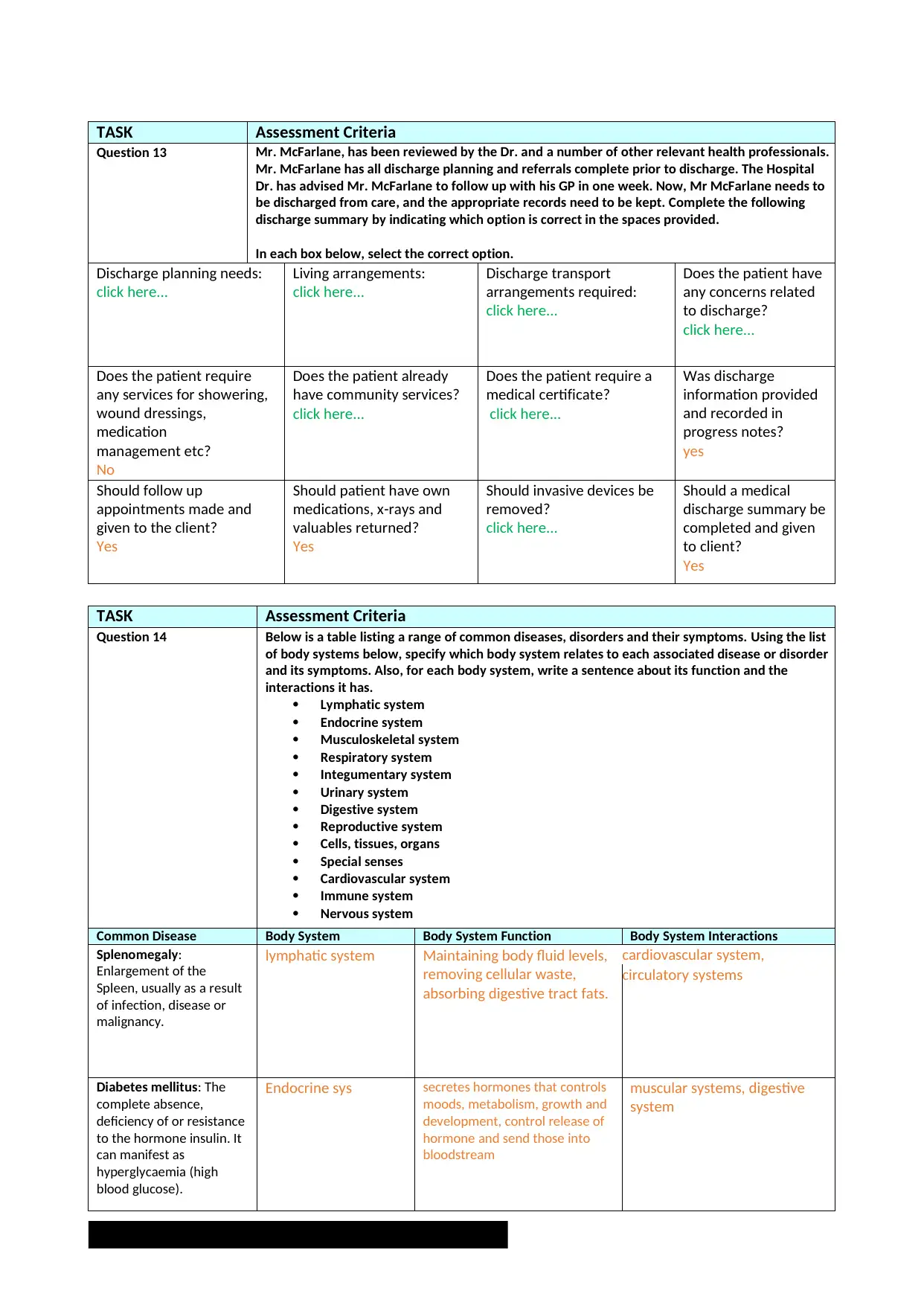
TASK Assessment Criteria
Question 13 Mr. McFarlane, has been reviewed by the Dr. and a number of other relevant health professionals.
Mr. McFarlane has all discharge planning and referrals complete prior to discharge. The Hospital
Dr. has advised Mr. McFarlane to follow up with his GP in one week. Now, Mr McFarlane needs to
be discharged from care, and the appropriate records need to be kept. Complete the following
discharge summary by indicating which option is correct in the spaces provided.
In each box below, select the correct option.
Discharge planning needs:
click here...
Living arrangements:
click here...
Discharge transport
arrangements required:
click here...
Does the patient have
any concerns related
to discharge?
click here...
Does the patient require
any services for showering,
wound dressings,
medication
management etc?
No
Does the patient already
have community services?
click here...
Does the patient require a
medical certificate?
click here...
Was discharge
information provided
and recorded in
progress notes?
yes
Should follow up
appointments made and
given to the client?
Yes
Should patient have own
medications, x-rays and
valuables returned?
Yes
Should invasive devices be
removed?
click here...
Should a medical
discharge summary be
completed and given
to client?
Yes
TASK Assessment Criteria
Question 14 Below is a table listing a range of common diseases, disorders and their symptoms. Using the list
of body systems below, specify which body system relates to each associated disease or disorder
and its symptoms. Also, for each body system, write a sentence about its function and the
interactions it has.
Lymphatic system
Endocrine system
Musculoskeletal system
Respiratory system
Integumentary system
Urinary system
Digestive system
Reproductive system
Cells, tissues, organs
Special senses
Cardiovascular system
Immune system
Nervous system
Common Disease Body System Body System Function Body System Interactions
Splenomegaly:
Enlargement of the
Spleen, usually as a result
of infection, disease or
malignancy.
lymphatic system Maintaining body fluid levels,
removing cellular waste,
absorbing digestive tract fats.
cardiovascular system,
circulatory systems
Diabetes mellitus: The
complete absence,
deficiency of or resistance
to the hormone insulin. It
can manifest as
hyperglycaemia (high
blood glucose).
Endocrine sys secretes hormones that controls
moods, metabolism, growth and
development, control release of
hormone and send those into
bloodstream
muscular systems, digestive
system
Question 13 Mr. McFarlane, has been reviewed by the Dr. and a number of other relevant health professionals.
Mr. McFarlane has all discharge planning and referrals complete prior to discharge. The Hospital
Dr. has advised Mr. McFarlane to follow up with his GP in one week. Now, Mr McFarlane needs to
be discharged from care, and the appropriate records need to be kept. Complete the following
discharge summary by indicating which option is correct in the spaces provided.
In each box below, select the correct option.
Discharge planning needs:
click here...
Living arrangements:
click here...
Discharge transport
arrangements required:
click here...
Does the patient have
any concerns related
to discharge?
click here...
Does the patient require
any services for showering,
wound dressings,
medication
management etc?
No
Does the patient already
have community services?
click here...
Does the patient require a
medical certificate?
click here...
Was discharge
information provided
and recorded in
progress notes?
yes
Should follow up
appointments made and
given to the client?
Yes
Should patient have own
medications, x-rays and
valuables returned?
Yes
Should invasive devices be
removed?
click here...
Should a medical
discharge summary be
completed and given
to client?
Yes
TASK Assessment Criteria
Question 14 Below is a table listing a range of common diseases, disorders and their symptoms. Using the list
of body systems below, specify which body system relates to each associated disease or disorder
and its symptoms. Also, for each body system, write a sentence about its function and the
interactions it has.
Lymphatic system
Endocrine system
Musculoskeletal system
Respiratory system
Integumentary system
Urinary system
Digestive system
Reproductive system
Cells, tissues, organs
Special senses
Cardiovascular system
Immune system
Nervous system
Common Disease Body System Body System Function Body System Interactions
Splenomegaly:
Enlargement of the
Spleen, usually as a result
of infection, disease or
malignancy.
lymphatic system Maintaining body fluid levels,
removing cellular waste,
absorbing digestive tract fats.
cardiovascular system,
circulatory systems
Diabetes mellitus: The
complete absence,
deficiency of or resistance
to the hormone insulin. It
can manifest as
hyperglycaemia (high
blood glucose).
Endocrine sys secretes hormones that controls
moods, metabolism, growth and
development, control release of
hormone and send those into
bloodstream
muscular systems, digestive
system
⊘ This is a preview!⊘
Do you want full access?
Subscribe today to unlock all pages.

Trusted by 1+ million students worldwide
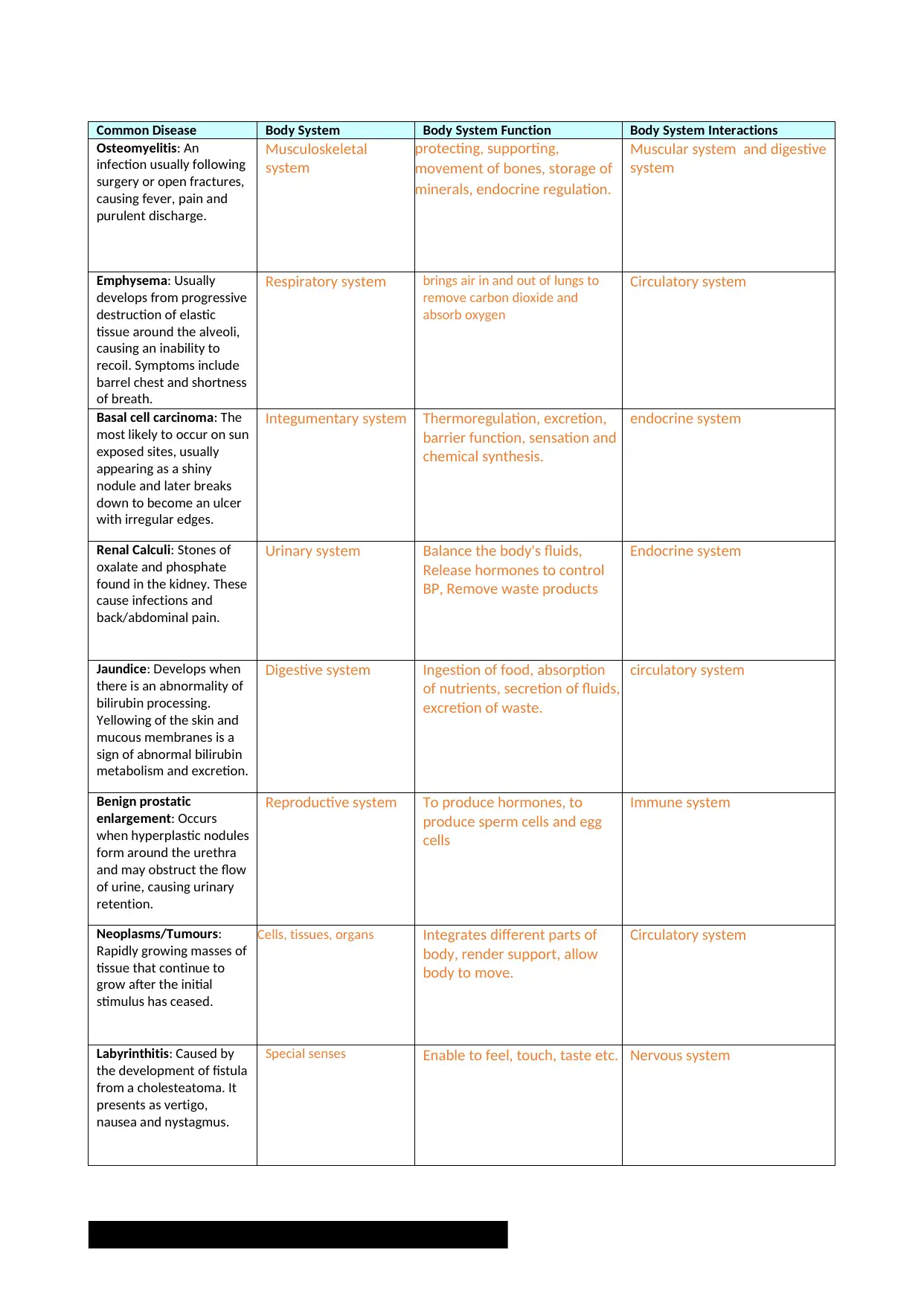
Common Disease Body System Body System Function Body System Interactions
Osteomyelitis: An
infection usually following
surgery or open fractures,
causing fever, pain and
purulent discharge.
Musculoskeletal
system
protecting, supporting,
movement of bones, storage of
minerals, endocrine regulation.
Muscular system and digestive
system
Emphysema: Usually
develops from progressive
destruction of elastic
tissue around the alveoli,
causing an inability to
recoil. Symptoms include
barrel chest and shortness
of breath.
Respiratory system brings air in and out of lungs to
remove carbon dioxide and
absorb oxygen
Circulatory system
Basal cell carcinoma: The
most likely to occur on sun
exposed sites, usually
appearing as a shiny
nodule and later breaks
down to become an ulcer
with irregular edges.
Integumentary system Thermoregulation, excretion,
barrier function, sensation and
chemical synthesis.
endocrine system
Renal Calculi: Stones of
oxalate and phosphate
found in the kidney. These
cause infections and
back/abdominal pain.
Urinary system Balance the body's fluids,
Release hormones to control
BP, Remove waste products
Endocrine system
Jaundice: Develops when
there is an abnormality of
bilirubin processing.
Yellowing of the skin and
mucous membranes is a
sign of abnormal bilirubin
metabolism and excretion.
Digestive system Ingestion of food, absorption
of nutrients, secretion of fluids,
excretion of waste.
circulatory system
Benign prostatic
enlargement: Occurs
when hyperplastic nodules
form around the urethra
and may obstruct the flow
of urine, causing urinary
retention.
Reproductive system To produce hormones, to
produce sperm cells and egg
cells
Immune system
Neoplasms/Tumours:
Rapidly growing masses of
tissue that continue to
grow after the initial
stimulus has ceased.
Cells, tissues, organs Integrates different parts of
body, render support, allow
body to move.
Circulatory system
Labyrinthitis: Caused by
the development of fistula
from a cholesteatoma. It
presents as vertigo,
nausea and nystagmus.
Special senses Enable to feel, touch, taste etc. Nervous system
Osteomyelitis: An
infection usually following
surgery or open fractures,
causing fever, pain and
purulent discharge.
Musculoskeletal
system
protecting, supporting,
movement of bones, storage of
minerals, endocrine regulation.
Muscular system and digestive
system
Emphysema: Usually
develops from progressive
destruction of elastic
tissue around the alveoli,
causing an inability to
recoil. Symptoms include
barrel chest and shortness
of breath.
Respiratory system brings air in and out of lungs to
remove carbon dioxide and
absorb oxygen
Circulatory system
Basal cell carcinoma: The
most likely to occur on sun
exposed sites, usually
appearing as a shiny
nodule and later breaks
down to become an ulcer
with irregular edges.
Integumentary system Thermoregulation, excretion,
barrier function, sensation and
chemical synthesis.
endocrine system
Renal Calculi: Stones of
oxalate and phosphate
found in the kidney. These
cause infections and
back/abdominal pain.
Urinary system Balance the body's fluids,
Release hormones to control
BP, Remove waste products
Endocrine system
Jaundice: Develops when
there is an abnormality of
bilirubin processing.
Yellowing of the skin and
mucous membranes is a
sign of abnormal bilirubin
metabolism and excretion.
Digestive system Ingestion of food, absorption
of nutrients, secretion of fluids,
excretion of waste.
circulatory system
Benign prostatic
enlargement: Occurs
when hyperplastic nodules
form around the urethra
and may obstruct the flow
of urine, causing urinary
retention.
Reproductive system To produce hormones, to
produce sperm cells and egg
cells
Immune system
Neoplasms/Tumours:
Rapidly growing masses of
tissue that continue to
grow after the initial
stimulus has ceased.
Cells, tissues, organs Integrates different parts of
body, render support, allow
body to move.
Circulatory system
Labyrinthitis: Caused by
the development of fistula
from a cholesteatoma. It
presents as vertigo,
nausea and nystagmus.
Special senses Enable to feel, touch, taste etc. Nervous system
Paraphrase This Document
Need a fresh take? Get an instant paraphrase of this document with our AI Paraphraser
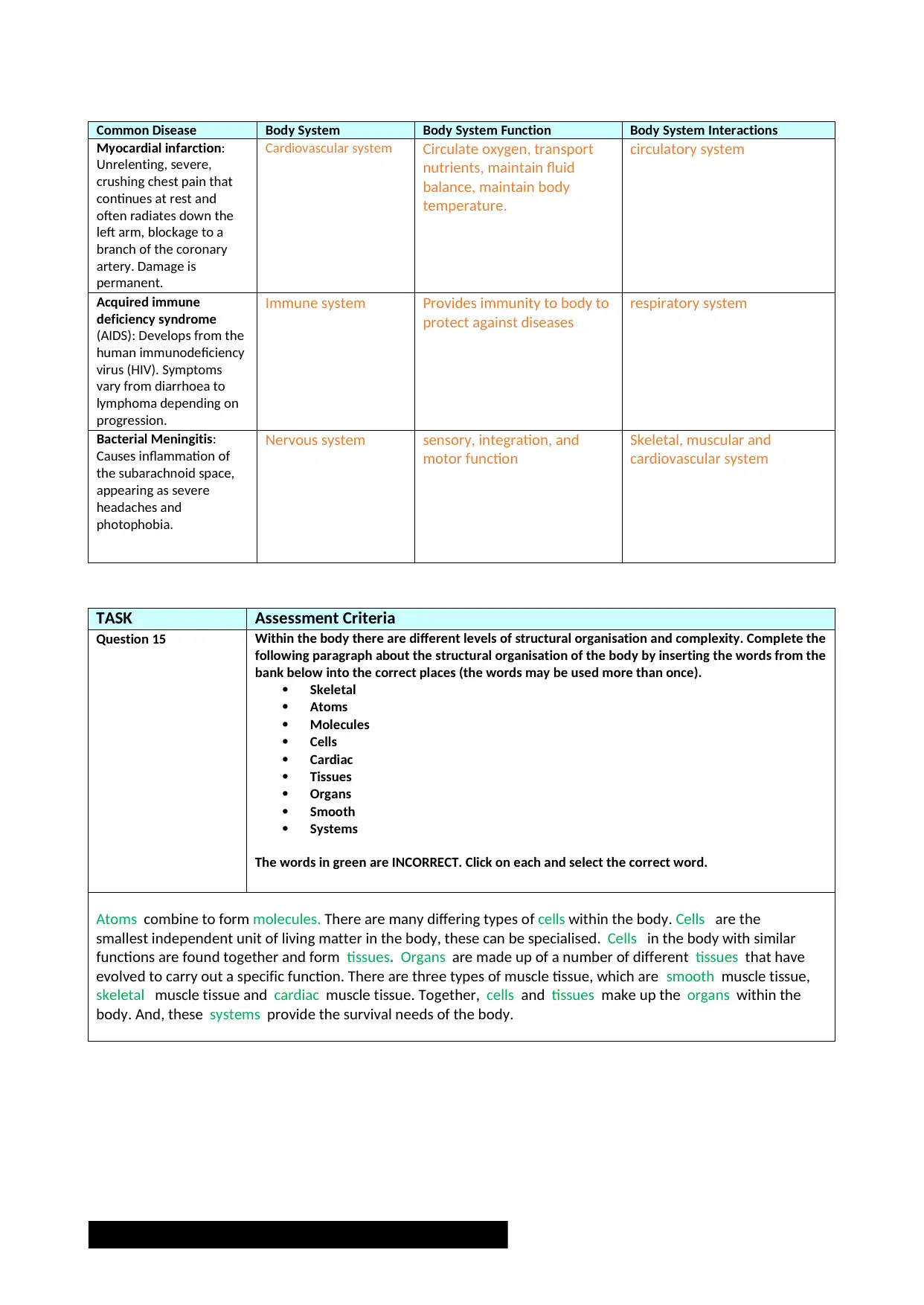
Common Disease Body System Body System Function Body System Interactions
Myocardial infarction:
Unrelenting, severe,
crushing chest pain that
continues at rest and
often radiates down the
left arm, blockage to a
branch of the coronary
artery. Damage is
permanent.
Cardiovascular system Circulate oxygen, transport
nutrients, maintain fluid
balance, maintain body
temperature.
circulatory system
Acquired immune
deficiency syndrome
(AIDS): Develops from the
human immunodeficiency
virus (HIV). Symptoms
vary from diarrhoea to
lymphoma depending on
progression.
Immune system Provides immunity to body to
protect against diseases
respiratory system
Bacterial Meningitis:
Causes inflammation of
the subarachnoid space,
appearing as severe
headaches and
photophobia.
Nervous system sensory, integration, and
motor function
Skeletal, muscular and
cardiovascular system
TASK Assessment Criteria
Question 15 Within the body there are different levels of structural organisation and complexity. Complete the
following paragraph about the structural organisation of the body by inserting the words from the
bank below into the correct places (the words may be used more than once).
Skeletal
Atoms
Molecules
Cells
Cardiac
Tissues
Organs
Smooth
Systems
The words in green are INCORRECT. Click on each and select the correct word.
Atoms combine to form molecules. There are many differing types of cells within the body. Cells are the
smallest independent unit of living matter in the body, these can be specialised. Cells in the body with similar
functions are found together and form tissues. Organs are made up of a number of different tissues that have
evolved to carry out a specific function. There are three types of muscle tissue, which are smooth muscle tissue,
skeletal muscle tissue and cardiac muscle tissue. Together, cells and tissues make up the organs within the
body. And, these systems provide the survival needs of the body.
Myocardial infarction:
Unrelenting, severe,
crushing chest pain that
continues at rest and
often radiates down the
left arm, blockage to a
branch of the coronary
artery. Damage is
permanent.
Cardiovascular system Circulate oxygen, transport
nutrients, maintain fluid
balance, maintain body
temperature.
circulatory system
Acquired immune
deficiency syndrome
(AIDS): Develops from the
human immunodeficiency
virus (HIV). Symptoms
vary from diarrhoea to
lymphoma depending on
progression.
Immune system Provides immunity to body to
protect against diseases
respiratory system
Bacterial Meningitis:
Causes inflammation of
the subarachnoid space,
appearing as severe
headaches and
photophobia.
Nervous system sensory, integration, and
motor function
Skeletal, muscular and
cardiovascular system
TASK Assessment Criteria
Question 15 Within the body there are different levels of structural organisation and complexity. Complete the
following paragraph about the structural organisation of the body by inserting the words from the
bank below into the correct places (the words may be used more than once).
Skeletal
Atoms
Molecules
Cells
Cardiac
Tissues
Organs
Smooth
Systems
The words in green are INCORRECT. Click on each and select the correct word.
Atoms combine to form molecules. There are many differing types of cells within the body. Cells are the
smallest independent unit of living matter in the body, these can be specialised. Cells in the body with similar
functions are found together and form tissues. Organs are made up of a number of different tissues that have
evolved to carry out a specific function. There are three types of muscle tissue, which are smooth muscle tissue,
skeletal muscle tissue and cardiac muscle tissue. Together, cells and tissues make up the organs within the
body. And, these systems provide the survival needs of the body.
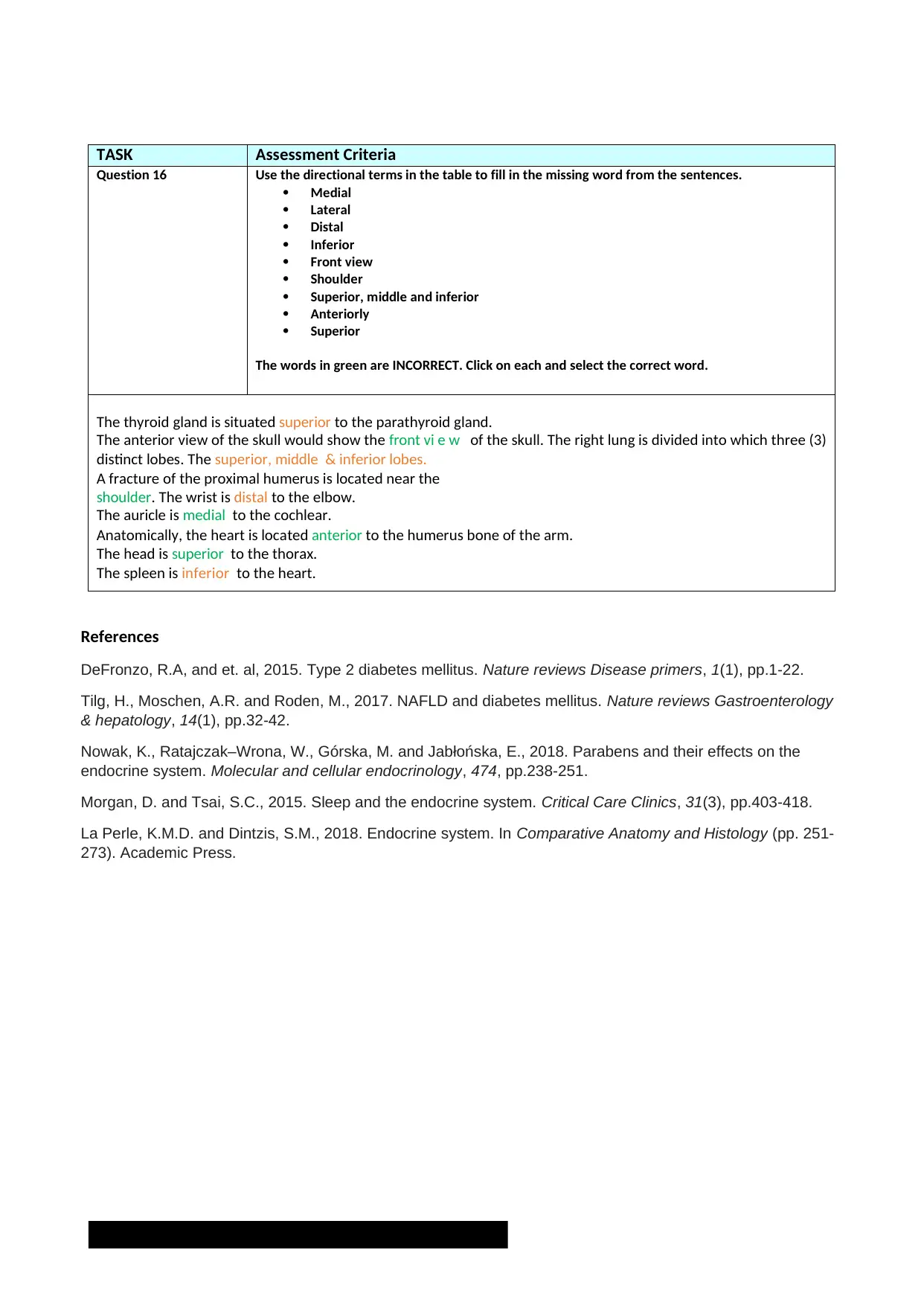
TASK Assessment Criteria
Question 16 Use the directional terms in the table to fill in the missing word from the sentences.
Medial
Lateral
Distal
Inferior
Front view
Shoulder
Superior, middle and inferior
Anteriorly
Superior
The words in green are INCORRECT. Click on each and select the correct word.
The thyroid gland is situated superior to the parathyroid gland.
The anterior view of the skull would show the front vi e w of the skull. The right lung is divided into which three (3)
distinct lobes. The superior, middle & inferior lobes.
A fracture of the proximal humerus is located near the
shoulder. The wrist is distal to the elbow.
The auricle is medial to the cochlear.
Anatomically, the heart is located anterior to the humerus bone of the arm.
The head is superior to the thorax.
The spleen is inferior to the heart.
References
DeFronzo, R.A, and et. al, 2015. Type 2 diabetes mellitus. Nature reviews Disease primers, 1(1), pp.1-22.
Tilg, H., Moschen, A.R. and Roden, M., 2017. NAFLD and diabetes mellitus. Nature reviews Gastroenterology
& hepatology, 14(1), pp.32-42.
Nowak, K., Ratajczak–Wrona, W., Górska, M. and Jabłońska, E., 2018. Parabens and their effects on the
endocrine system. Molecular and cellular endocrinology, 474, pp.238-251.
Morgan, D. and Tsai, S.C., 2015. Sleep and the endocrine system. Critical Care Clinics, 31(3), pp.403-418.
La Perle, K.M.D. and Dintzis, S.M., 2018. Endocrine system. In Comparative Anatomy and Histology (pp. 251-
273). Academic Press.
Question 16 Use the directional terms in the table to fill in the missing word from the sentences.
Medial
Lateral
Distal
Inferior
Front view
Shoulder
Superior, middle and inferior
Anteriorly
Superior
The words in green are INCORRECT. Click on each and select the correct word.
The thyroid gland is situated superior to the parathyroid gland.
The anterior view of the skull would show the front vi e w of the skull. The right lung is divided into which three (3)
distinct lobes. The superior, middle & inferior lobes.
A fracture of the proximal humerus is located near the
shoulder. The wrist is distal to the elbow.
The auricle is medial to the cochlear.
Anatomically, the heart is located anterior to the humerus bone of the arm.
The head is superior to the thorax.
The spleen is inferior to the heart.
References
DeFronzo, R.A, and et. al, 2015. Type 2 diabetes mellitus. Nature reviews Disease primers, 1(1), pp.1-22.
Tilg, H., Moschen, A.R. and Roden, M., 2017. NAFLD and diabetes mellitus. Nature reviews Gastroenterology
& hepatology, 14(1), pp.32-42.
Nowak, K., Ratajczak–Wrona, W., Górska, M. and Jabłońska, E., 2018. Parabens and their effects on the
endocrine system. Molecular and cellular endocrinology, 474, pp.238-251.
Morgan, D. and Tsai, S.C., 2015. Sleep and the endocrine system. Critical Care Clinics, 31(3), pp.403-418.
La Perle, K.M.D. and Dintzis, S.M., 2018. Endocrine system. In Comparative Anatomy and Histology (pp. 251-
273). Academic Press.
⊘ This is a preview!⊘
Do you want full access?
Subscribe today to unlock all pages.

Trusted by 1+ million students worldwide
1 out of 12
Your All-in-One AI-Powered Toolkit for Academic Success.
+13062052269
info@desklib.com
Available 24*7 on WhatsApp / Email
![[object Object]](/_next/static/media/star-bottom.7253800d.svg)
Unlock your academic potential
Copyright © 2020–2025 A2Z Services. All Rights Reserved. Developed and managed by ZUCOL.


